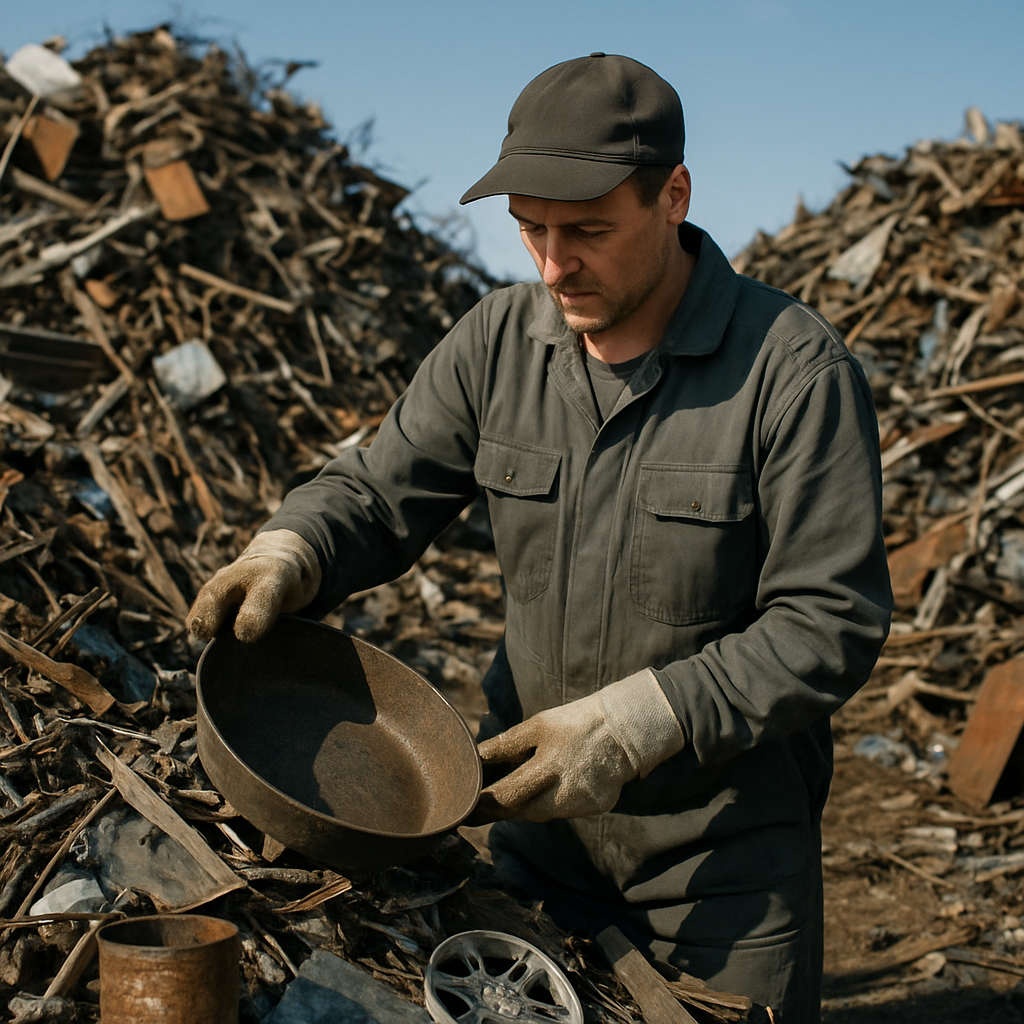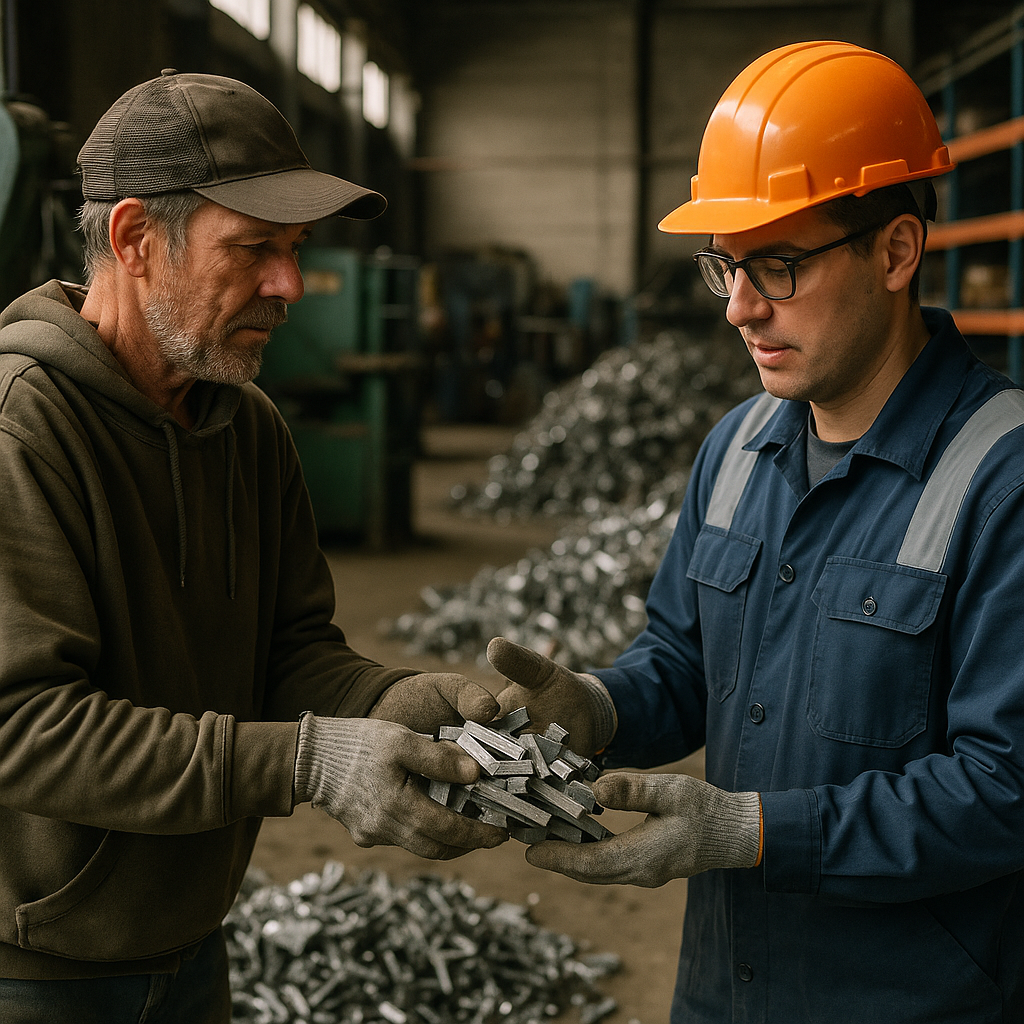5901 Botham Jean Blvd, Dallas, TX 75215
What Do Scrap Metal Collectors Do? Environmental and Economic Impact Explained
August 19, 2025Recycling one ton of steel saves approximately 2,500 pounds of iron ore, 1,400 pounds of coal, and 120 pounds of limestone. Behind these impressive numbers are the unsung heroes of the recycling industry: scrap metal collectors. These dedicated individuals form the crucial first link in the metal recycling chain by gathering discarded metal items that would otherwise occupy landfills for centuries.
Scrap metal collectors carry out the essential task of identifying, collecting, and sorting various metals from diverse sources. From construction sites to residential neighborhoods, they rescue valuable resources from being wasted. Their work directly supports conservation efforts by reducing the need for environmentally damaging mining operations that cause habitat destruction, soil erosion, and water contamination.
Beyond environmental protection, scrap metal collectors also significantly contribute to economic sustainability. The recycling industry employs hundreds of thousands of people and generates billions in economic activity annually. By transforming what many consider trash into valuable commodities, these collectors create a circular economy where resources remain in use for as long as possible. Their daily efforts represent an ideal blend of environmental stewardship and practical economic benefit.
What Do Scrap Metal Collectors Actually Do?
Scrap metal collectors are the first critical link in the metal recycling chain. These professionals identify, gather, and process discarded metal items that would otherwise end up in landfills. Their work requires both physical stamina and specialized knowledge to transform what many consider junk into valuable recyclable resources.
The collection process involves several key steps to ensure metals are properly recovered and prepared for recycling. Let’s examine what scrap metal collectors do on a day-to-day basis.
The Collection Process
Scrap metal collectors acquire materials from various sources, including homes, businesses, demolition sites, and manufacturing facilities. Some offer pickup services where customers can schedule the collection of larger items like appliances or automotive parts.
Collection methods vary based on volume and material types. For smaller operations, collectors might use pickup trucks with organized compartments. Larger commercial collectors often employ specialized vehicles with hydraulic lifting equipment for handling heavier loads.
During collection, professionals must quickly assess the value of items. This requires knowledge of current market prices and the ability to identify valuable components that might be hidden within larger items.
Sorting and Material Identification
A crucial skill for scrap metal collectors is identifying and sorting different types of metals. This identification process directly impacts the value of collected materials.
- Ferrous vs. non-ferrous separation: Collectors use magnets to distinguish iron-containing metals from more valuable non-ferrous materials like copper, aluminum, and brass.
- Visual inspection: Experienced collectors can identify many metals by color, weight, and texture.
- Density testing: Simple tests help differentiate between similar-looking metals with different values.
- Material grading: Collectors categorize materials by quality, purity, and market value.
Proper sorting is essential because mixing different metal types reduces their recycling value. A load of pure copper commands a much higher price than mixed materials.
Processing and Preparation
Before transport to recycling facilities, collectors must prepare materials. This preparation stage involves several important tasks:
First, collectors remove non-metal components such as plastic, rubber, or glass that might contaminate the recycling process. For example, when processing a refrigerator, they strip away insulation, shelving, and electronic components before recovering the valuable metal shell and components.
Next comes size reduction. Collectors often need to cut, break, or compact larger items to make transportation more efficient. This might involve using tools like metal shears, torches, or hydraulic compactors to reduce volume.
Transportation and Facility Delivery
Once materials are collected, sorted, and prepared, collectors transport them to recycling facilities or scrap yards. These facilities weigh the materials and pay the collector based on current market rates for each metal type.
The transportation stage requires knowledge of local regulations regarding the hauling of scrap materials. Collectors must secure their loads properly to prevent items from falling during transit. Many jurisdictions have specific requirements for transporting scrap metal to prevent theft and ensure safety.
Market Knowledge and Business Management
Beyond the physical aspects of collection, successful scrap metal collectors must understand market dynamics. Metal prices fluctuate daily based on global supply and demand factors. Smart collectors track these changes to know when to hold materials for better prices or when to sell quickly.
Many collectors develop relationships with regular suppliers and buyers. Building these connections helps ensure a steady supply of materials and favorable terms with recycling facilities. Some collectors specialize in specific types of scrap, such as electronic waste or automotive parts, developing expertise that adds value to their services.
Collectors must also maintain proper documentation. Most jurisdictions require records of transactions to prevent the sale of stolen materials. This paperwork includes details about the source of materials, weights, and transaction amounts.
| Metal | Typical Sources |
|---|---|
| Steel | Appliances, old furniture, construction materials |
| Cast Iron | Old pipes, radiators, cookware |
| Aluminum | Cans, foil, window frames, appliances |
| Copper | Electrical wires, plumbing pipes, old appliances |
| Brass | Plumbing fittings, doorknobs, musical instruments |
| Lead | Old batteries, piping, weights |
Environmental and Economic Impact
The work of scrap metal collectors delivers significant environmental benefits. By diverting metals from landfills, they conserve natural resources and reduce the energy required for new metal production. Recycling aluminum, for instance, uses 95% less energy than producing it from raw materials.
From an economic standpoint, collectors create value from what would otherwise be waste. They support local economies by providing disposal solutions for businesses and homeowners while feeding valuable raw materials back into the manufacturing supply chain.
As sustainability concerns grow, the role of scrap metal collectors becomes increasingly important. These professionals represent the crucial first step in transforming waste into resources, making them essential players in the circular economy.
Why Are Scrap Metal Collectors Important for the Environment?

Scrap metal collectors serve as frontline environmental guardians by preventing valuable metals from entering landfills. Their work creates a crucial link in the recycling chain that yields significant environmental benefits. When collectors gather and sort metals for recycling, they initiate a process that consumes up to 95% less energy than producing new aluminum from raw materials and 60% less energy for steel production.
The environmental impact of scrap metal collectors extends well beyond energy conservation. By diverting metals from waste streams, collectors help preserve finite natural resources that would otherwise be depleted through mining. Recycling just one ton of steel conserves approximately 2,500 pounds of iron ore, 1,400 pounds of coal, and 120 pounds of limestone that would be extracted through environmentally damaging mining operations.
Greenhouse gas reduction is another critical benefit of collectors’ work. The decreased energy requirements of metal recycling translate directly into lower carbon emissions. Studies show that recycling steel and aluminum can reduce greenhouse gas emissions by 86% and 95%, respectively. This substantial reduction helps combat climate change amid rising global temperatures.
Scrap metal collectors also play a vital role in preventing toxic contamination. Many metals contain harmful chemicals like lead, mercury, and cadmium, which can leach into soil and groundwater when improperly disposed of in landfills. By ensuring these materials enter the recycling stream instead, collectors help protect both ecological systems and human health from dangerous pollutants.
Water conservation represents yet another environmental benefit of metal recycling facilitated by collectors. Traditional metal production is extremely water-intensive, while recycling can reduce water usage by up to 90% for some metals, like copper. In regions facing water scarcity, this conservation aspect becomes increasingly important.
The circular economy benefits of scrap metal collection extend beyond immediate environmental impacts. Unlike many materials that degrade during recycling, metals maintain their integrity through multiple recycling cycles. This unique property allows metals to be reintroduced into manufacturing processes indefinitely, creating a sustainable resource loop that breaks the traditional take-make-dispose pattern of consumption.
The ripple effects of scrap metal collection include habitat preservation and biodiversity protection. Mining operations often destroy natural landscapes and disrupt ecosystems. The Northeast Recycling Council reports that recycled steel alone delivers an 86% reduction in air pollution and a 76% reduction in water pollution compared to virgin production. These pollution reductions help maintain healthier ecosystems for wildlife and plant species.
By supporting the work of scrap metal collectors through proper metal disposal and recycling practices, individuals and businesses contribute to a more sustainable future. Each piece of metal diverted from landfills represents a small but meaningful step toward environmental conservation and resource stewardship.
How Do Scrap Metal Collectors Contribute to the Economy?

Scrap metal collectors are the backbone of a thriving economic engine. The Institute of Scrap Recycling Industries reports that the recycling industry generates over $105 billion in annual economic activity in the United States alone. This substantial figure underscores the crucial role these collectors play in our national economy.
The impact on job creation is particularly noteworthy. The scrap metal recycling sector supports approximately 470,000 jobs throughout the country, including about 150,000 direct positions in processing facilities, which pay an average of $77,000 in wages and benefits. Additional jobs arise in supporting industries that supply equipment, transportation, and services to recyclers.
Beyond direct employment, scrap metal collection produces a ripple effect throughout manufacturing. By supplying a steady stream of raw materials, collectors help manufacturers reduce production costs by up to 33% compared to using virgin materials. For example, using recycled aluminum requires only 5% of the energy needed to produce new aluminum from bauxite ore. This energy savings directly translates to lower costs and more competitive pricing for domestic manufacturers.
The economic benefits also extend to government revenues. The recycling industry generates approximately $4.4 billion in state and local tax revenue annually, along with an additional $6.8 billion for the federal government. These funds support crucial public services and infrastructure development.
Furthermore, scrap metal collectors enhance supply chain resilience. By providing a reliable secondary source of materials, they enable manufacturers to avoid price volatility and supply disruptions in primary metal markets. This stability is increasingly important as global supply chains face ongoing challenges and uncertainties.
The export market offers another significant economic contribution. About 26.8% of the scrap metal industry’s economic activity is from exports, creating approximately 125,000 jobs. This international trade generates $28.3 billion in economic benefits, including substantial tax revenues at all government levels.
As manufacturing adapts to meet sustainability goals, scrap metal collectors play an even more essential role. The rising demand for metals in green technologies – from electric vehicles to wind turbines – creates new market opportunities. For example, the increasing global demand for aluminum could be met by sourcing 50% from recycled materials, creating a sustainable balance while supporting economic growth.
The scrap metal collection industry serves as a leading economic indicator. As the initial link in the manufacturing chain, the health of this sector often signals broader economic trends. Despite occasional market fluctuations, the industry has demonstrated remarkable resilience, continuing to drive economic activity even during challenging periods.
Scrap metal collectors also provide significant value at the local level. Both small-scale collectors and larger recycling operations contribute to community development through employment opportunities and business activity. This grassroots economic impact benefits urban and rural areas nationwide.
| Economic Impact | Details |
|---|---|
| Annual Economic Activity | $105 billion |
| Jobs Created | 500,000+ |
| State and Local Tax Revenue | $4.4 billion |
| Federal Tax Revenue | $6.8 billion |
| Export Economic Activity | $28 billion |
| Direct Jobs from Exports | 40,000 |
| Additional Jobs from Supplier Operations | 93,000 |
By reducing reliance on imported raw materials, collectors strengthen domestic industries and improve the nation’s trade balance. This self-sufficiency becomes increasingly important as countries worldwide compete for limited resources. Through their daily work, scrap metal collectors don’t just clean up our communities – they contribute to building a stronger, more sustainable economy.
Challenges and Opportunities in Scrap Metal Collection
Market Volatility and Price Fluctuations
Scrap metal collectors operate in a market marked by significant price volatility. Global economic trends, trade policies, and supply-demand imbalances create unpredictable pricing environments that directly affect profitability. Metal prices can swing dramatically within short periods, complicating financial planning for collection operations.
This volatility requires collectors to develop strategic approaches to buying and selling. Some implement hedging strategies to mitigate risk, while others focus on diversifying the types of metals they collect to balance exposure to price fluctuations within any single metal category.
Successful collectors often establish robust market monitoring systems to track price trends and adjust their operations accordingly. Building strong relationships with end buyers can also help secure more stable pricing arrangements through longer-term contracts.
Regulatory Compliance Challenges
The scrap metal industry faces increasingly strict regulations designed to prevent theft and ensure environmental protection. These regulations vary by location but typically include detailed documentation of purchases, seller identification verification, and material handling protocols.
For smaller collection operations, compliance can be resource-intensive. Maintaining proper records, implementing security measures, and training staff on compliance protocols add significant operational costs. However, collectors excelling at compliance gain competitive advantages through stronger relationships with legitimate suppliers and authorities.
Modern compliance software systems can help streamline these processes. These digital tools automate record-keeping, verify identities, and generate required reports for authorities, reducing administrative burdens.
Technological Opportunities for Enhanced Efficiency
Adopting technology presents significant opportunities for scrap metal collectors. Advanced sorting technologies using sensors, X-ray fluorescence (XRF), and artificial intelligence improve material identification and processing. These innovations enable more precise sorting of mixed metals, increasing the value recovered from collected materials.
Mobile applications now allow collectors to manage logistics more efficiently, optimize collection routes, and provide real-time pricing information to suppliers. Some leading collectors are implementing blockchain technology to enhance traceability and transparency throughout the supply chain.
The integration of drones equipped with LiDAR sensors offers new capabilities for inventory management and yard optimization. These aerial systems can quickly assess stockpile volumes and identify operational inefficiencies that might otherwise go unnoticed.
| Innovation | Description |
|---|---|
| Smart Sorting Systems | Utilizes AI technologies like X-ray fluorescence (XRF) and laser-induced breakdown spectroscopy (LIBS) for accurate metal identification and sorting, reducing labor costs and improving throughput. |
| Drones and LiDAR Technology | Used to monitor scrapyards, assess inventory, and identify safety hazards in real-time, optimizing operations and ensuring safe environments. |
| AI and Data-Driven Analytics | Enhances process optimization and market prediction, assisting in inventory management and decision-making for recyclers. |
| Robotics and Automation | Improves material sorting and handling, increasing efficiency and safety through tasks like lifting and stacking materials. |
| Blockchain Technology | Ensures traceability and transparency in the recycling supply chain by recording and authenticating transactions securely. |
Community Education and Engagement
Effective community education programs represent a significant opportunity for collectors to boost participation in metal recycling. Many consumers remain unaware of which items contain recyclable metals or how to properly prepare them for recycling.
Forward-thinking collectors are developing educational initiatives targeting schools, community organizations, and local businesses. These programs highlight the environmental and economic benefits of metal recycling while providing practical guidance on proper recycling practices.
Social media campaigns and community events offer additional engagement channels. Some collectors host open house events or recycling drives that make the collection process more accessible and build positive relationships with potential suppliers.
Sustainability and Circular Economy Integration
The increasing focus on sustainability and circular economy principles presents new avenues for collectors to expand their impact. Manufacturers are actively seeking recycled materials to reduce their environmental footprint and meet sustainability goals.
Collectors can position themselves as essential partners in the circular economy by highlighting how their services help close material loops and reduce reliance on virgin resources. This strategic positioning can lead to stronger partnerships with manufacturers and larger volume contracts.
Some innovative collectors are exploring vertical integration opportunities, such as processing collected materials into manufacturing-ready forms or developing specialized recycling solutions for emerging materials like battery components from electric vehicles.
Competitive Landscape Challenges
Competition from both formal and informal operators presents ongoing challenges for legitimate collectors. Unregulated operators may cut corners on environmental practices or compliance requirements, allowing them to offer higher purchase prices to suppliers.
To compete effectively, established collectors must emphasize their value proposition beyond simply offering competitive prices. This includes highlighting their reliability, compliance credentials, environmental practices, and additional services like container placement or regular pickup schedules.
Building strong brand recognition and customer loyalty through excellent service helps create defensible market positions even in highly competitive environments. Specializing in certain material types or industry sectors can also help collectors differentiate themselves from general competition.
Conclusion: Supporting the Essential Work of Scrap Metal Collectors

Scrap metal collectors are the unsung heroes of sustainability efforts. These dedicated individuals play a crucial role in resource conservation by diverting valuable metals from landfills and recycling them. Their work helps reduce the need for environmentally harmful mining practices while significantly cutting energy consumption and greenhouse gas emissions.
The environmental and economic benefits of scrap metal collection extend further than many realize. Each piece of recycled metal represents a substantial energy saving compared to producing new metal from raw materials. Research shows that recycling aluminum saves up to 95% of the energy required for extracting new aluminum, while steel recycling saves about 60%. These energy reductions lead to fewer carbon emissions and a smaller environmental footprint for everyday products. Additionally, scrap metal recycling creates stable jobs and stimulates local economic growth in communities nationwide.
Want to make a difference? Contact Okon Recycling at 214-717-4083 for your recycling needs. Their expert team can help you transform discarded metals into valuable resources for a greener, more sustainable future.
